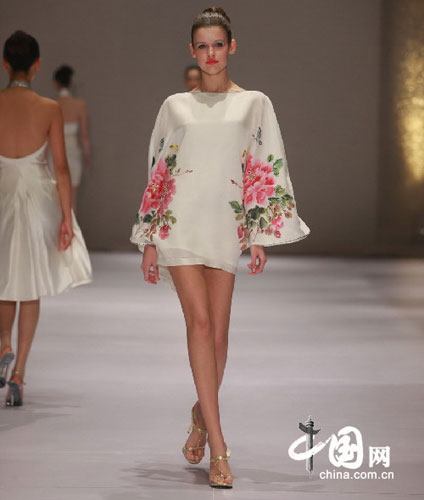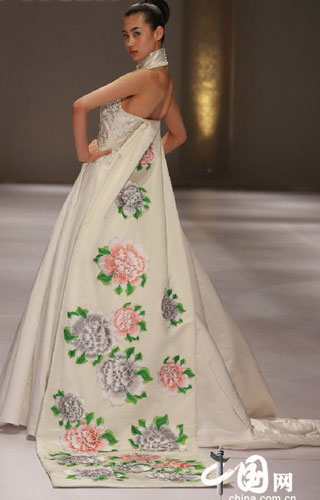
It is the embroidery that offers the most spectacular results. Zhang Zhifeng has promised a celebration of China's 'national beauty', the peony flower, and he delivers bouquets of them by the armful. The Chinese style is generally more extravagant in its ornamentation than contemporary western tastes might appreciate, but working in a genre as luxurious as Hua Fu, even when Zhang embellishes his floral decorations with crystals the effect is not overdone.
The dresses are presented in sequence, by color: deep blues, pale yellows, creamy ivories, rich reds, strong greens, and finally dramatic blacks. Each color in its turn seems to have outdone its predecessors, only to be immediately challenged by its successor.

The show concludes with all eighty models and dresses together on the floor en masse. Zhang Zhifeng takes the opportunity to make an appearance flanked by two unpretentious old men; one is Wang Jialiang, the fifth generation of a dynasty of Kesi practitioners whose family made clothes for royalty, the other is Wang Yuxiang, the master who is above all responsible for the survival of the Kesi skills that were on the brink of extinction. They more than merit the tribute paid to them by Zhang.
Photos can do the NE·TIGER Hua Fu collection some justice, but the work needs to be seen and admired in life to be properly appreciated. At the after-show party some of the models circulate in their dresses to give the public an opportunity for a close-up examination of their finesse and craftsmanship. Zhang has vowed to make NE·TIGER a luxury brand of world renown. I hope that he makes good on his promise, and succeeds in bringing the splendor of his Hua Fu u creations to a wider international audience.
(China.org.cn November 6, 2008)